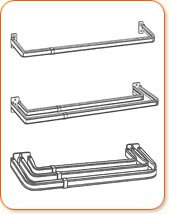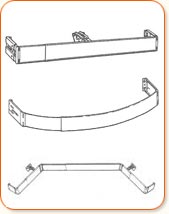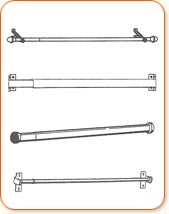Making Your Curtain Rod or Traverse Rod Stronger
If you need to hang long or heavy drapes, you can increase the strength of your curtain rod or traverse rod by ordering a telescoping rod with a minimum width near your window size.
For instance, for a 48" window, order a telescoping rod that fits a 48" to 84" window and you'll double-up the rod thickness making for a studier rod.
Curtain Rod Styles Include Standard, Valance, Sash, Cafe And Continental
The rod-pocket size of your valance or drapery will help you determine which Kirsch Curtain Rod you will need. Standard or Valance rods are made for small pockets and Continental Rods are made for wide pockets. Sheers typically fit a standard Curtain Rod.
Standard Curtain Rods In Single, Double And Triple

The most common Curtain Rod is the standard Kirsch Lockseam Curtain Rod. This style is popular for hanging valances, sheers or stationary panels.
These standard Curtain Rods are manufactured to fit a rod-pocket with a depth of 1 1/2".
The single Curtain Rods are available with clearances from about 1" to 4". The double Curtain Rods have a maximum clearance of 2" while the triple clears about 1" from the back rod.
Continental Curtain Rods Allow For Wide Rod-Pockets

Continental Curtain Rods are made almost exclusively for valance top treatments. You probably wouldn't want to hang stationary panels or sheers on a Continental Rod.
The Continental I Rods have a 4 1/2" face which allows for a pocket depth of 5 1/2".
The Continental II Rods have a 2 1/2" face which allows for a pocket depth of 3".
Continental II Rods are also made as curved, bay window or valance rods. There are many options for Continental Rods.
Smaller Curtain Rods Like Sash Or Cafe Are Great In Tight Areas

Sash, cafe, spring pressure and door rods are great minimum clearance rods for tight places. Just remember, these rods aren't meant to take a lot of weight, so don't hang heavily lined or interlined draperies from these small rods. Sheers or a face panel are fine, though.
Cafe rods are very popular because of their decorative look and brass finish.
Sash rods are frequently used on doors at the top and bottom to hold a panel in place.
And, spring pressure rods are used just about everywhere else. They are great for openings where you need to hang a drapery or panel, like at the entrance of a pantry.
We could probably start a whole new website devoted exclusively to all of the different styles you can find for curtain rods. No matter where you need to hang a curtain, there's a curtain rod specifically designed for you! Most of the time, you're probably going to need a standard curtain rod for your drapery or valance. But, if find yourself in an unusual situation, it's good to understand all of the different options available with Kirsch curtain rods.
While you may not use them as often, special purpose curtain rods come in handy if you're tring to hang a drapery on a door or within an open space like the entrance to a cupboard. For draperies on a door, you'll most likely want to use either a pre-made door rod or a flat sash rod. These type of rods work great on doors because of their reduced clearance. These smaller scale curtain rods won't keep the door from opening all the way if there are obstructions. The rod hangs very close to the mounting surface so you won't have to worry about it getting in the way.
There are two ways to hang a curtain rod in an open space. The easiest way to find a spring pressure curtain rod that will fit your opening. If you can't use a spring pressure rod, the other type of Kirsch drapery hardware that could work would be an inside mount socket style rod.
Kirsch makes drapery hardware in both of these styles so you can hang draperies on a door or within an open space. And, Kirsch curtain rods are available as single, double or triple. This makes it really easy to layer different fabrics to create a unique treatment. If you're looking for wide face curtain rods, the Kirsch Continental rods are a good choice. For rod pockets around three inches, the Kirsch curtain rod to buy would be the Continental II. And, for the larger rod pockets like five inches, the Kirsch Continental I would be fine.
©2024, Designer Drapery Hardware, LLC


